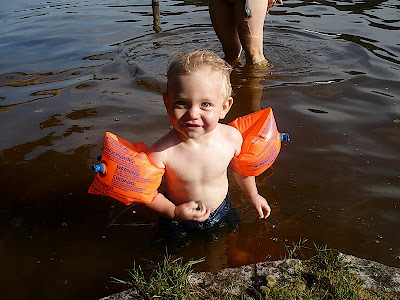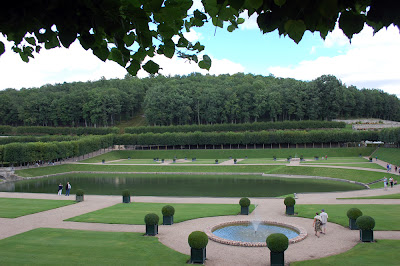The weather is not a central topic of conversation when you live in California, where I grew up. There, of course, weather is fairly predictable and unchanging. I have always enjoyed the conceit in LA Story, where Steve Martin, as weatherman, tapes his transmissions several days in advance to be broadcast later. I think the last couple of years in California have been much less "normal," but still, I doubt that the weather has become an important subject when people get together there. In our region of France the weather is a part of almost every conversation. There is a saying here: "If you don't like the weather, just wait five minutes." It's absolutely true that our weather changes quickly and dramatically. We can have a taste of three or four seasons in the space of a few hours. Thus I often imagine some meteorological observation as a fitting opening paragraph to my blog posts, as it is much on my mind and in my daily encounters.
This week has seen bright sunny warm days, as well as heavy rainfalls and really chilly moments. There was an especially golden full moon. A harvest moon. Autumn officially has begun. We ordered our heating oil and called a local farmer to deliver several cords of wood, ready for our four working fireplaces (we have nine total in the house) to be ready once the weather makes a sharp turn towards the cold. It hasn't yet, but we've had a few hints. We're at that transitional point. It's a charming, if achingly temporary moment of the year. Surely one of the most beautiful.
September is one of the most popular months of all the year for French weddings. We have been full every weekend with a series of local marriages. It keeps our business humming right through the month, even after the holiday-makers have taken the kids back home.
***
Another thing which keeps our business going are friends of friends. Buzz and Ginger who stayed with us earlier in the season, have referred several people to us. We were happy to welcome Mina, from Myrtle Beach, South Carolina, last week. She stayed with us for three nights and was a lovely presence.
Mina has a business making gluten-free products. She is so allergic to gluten that any consumption is actually life-threatening. Apparently that means not only avoiding bread and flour, but lots of other processed products. She was in France as a consultant to a company in Paris. Maison Conti was the rest-stop before the work. I cooked meals for her, but she brought her own breakfast pastry. She let us try it, and it was really fantastic!
Next week we welcome some other friends of Buzz and Ginger.
Mina has a business making gluten-free products. She is so allergic to gluten that any consumption is actually life-threatening. Apparently that means not only avoiding bread and flour, but lots of other processed products. She was in France as a consultant to a company in Paris. Maison Conti was the rest-stop before the work. I cooked meals for her, but she brought her own breakfast pastry. She let us try it, and it was really fantastic!
Next week we welcome some other friends of Buzz and Ginger.
***
There is certainly a passage that occurs when one becomes a grandparent. Another must surely be when the youngest child finally takes all his boxes of stuff out of your garage and moves away with them! We have carried James' 12 boxes of miscellany across the seas and moved them from one place to another. But now there is a big hole in our garage where once the cardboard boxes were stacked high! That really seems quite strange. He loaded them all into the rental truck, but couldn't resist unpacking just one box of posters and photos for a walk down memory lane.
While the "boys" were here they requested an etching course. I had such a good time with them! Adric is an artist but James has usually avoided art. He told me as a child that he thought I worked much too hard as a graphic artist. I guess he felt he equated art with work, not fun. Neither of them had done printmaking before and they both loved the technicality of it. I taught them three techniques, soft ground, hard ground and aquatint, which they used on different areas of one plate. Their results were wonderful. They seemed to be pleased and talked of future projects.
I always do a demo plate, but very rarely print it, since it's just for showing techniques to students. But in this case I rather liked the image that emerged. This is a soft and hard ground combination which I inked up and printed.
I added an aquatint, by way of demonstrating the technique. I was pretty sure I wouldn't like the effect, but I etched and printed it anyway. As expected, I prefered the image without the tone, but it was still interesting in its own right.
It's not easy to go back once you've added your aquatint, so I let all that be and started over on a slightly larger plate and created a whole new image. I call it Boy in a Plaid Shirt.
There were days that simply cried out to be enjoyed outdoors this week. We took a walk in the woods one early afternoon and enjoyed the quality of autumn light as it played among the branches.
Adric noticed some wild mushrooms which reminded me that this is mushroom gathering season. The French love to take to the woods this time of year and collect edible mushrooms by the basketfull. Most of the people we know are experts at identifying them and soups, salads and main dishes filled with wild mushrooms are served up on many tables this time of year. When I was at university, and lived in Oregon, I took a field guide and went out in the woods behind our house to identify mushrooms to bring home and cook. Those were the days before I read about an Asian family who moved to the San Francisco Bay Area and found some mushrooms they recognized from back home, cooked them up into a sauce and then had to be rushed off to the hospital. The entire family lost one of their internal organs and barely survived. That local news story affected lots of other people I know and I don't think any of us has felt very safe with a wild mushroom ever since. Here in France you can bring a mushroom to the pharmacy and they will identify it definitively for you.
I have no idea if the ones we noted are edible of not, but I would be very reluctant to take the chance. Luckily our local grocer also sells wild mushrooms this time of year, and I'd just as soon let the experts do the gathering. I don't mind paying for them. They are wonderful and I have a very nice recipe for warm wild mushroom salad with curls of Parmesan cheese. It can only be made during a very brief time of the year when these delicacies are available.
***
This week we received a coffee care package from our friends Wolfgang and Sabine, who I wrote about two weeks ago. While they were here earlier in the month, the conversation turned to coffee and we discovered yet another area of common ground (no pun intended). Coffee fanaticism. Wolfgang has a really gorgeous espresso machine and, like Rick, can't imagine a day that is not punctuated by cups of perfectly brewed coffee from ideally roasted beans.
When we lived in the San Francisco Bay Area, we always bought our coffee at Peets, one of the first and finest European style coffee roasters in the United States. It was Mr. Peet, a Dutch man who opened his first shop in Berkeley in 1966, and taught the mega coffee founders of Starbucks how to roast. They were his employees at one time. The secret to good coffee is mostly in the roasting, at least if you have good beans to begin with. The trouble with Starbucks is that their volume is so huge that they are forced to buy the good, the bad and the ugly coffee beans in order to have enough for all the cups of coffee they brew. The coffee bean is a seasonal product, after all, and therefore the highest quality beans are limited. For the first year that we lived in France a friend in California sent us Peets beans every month. After being spoiled like that for so long, it was hard for us to adjust to life without really good beans. In our local area we could find nothing that approached what we were used to. Even in Paris, at one of the most well known suppliers in France, Café Richard, the beans are not at all the same. They are dry, which indicates that they've been roasted too fast. A really well roasted bean is greasy, and that oil on the bean's surface is responsible for the crema on the top of an excellent cup of coffee.
It is only within the last year that we had found a roaster in Le Mans who could approximate the coffee we had from Peets. Even I have become a coffee snob, and I know when the beans are inferior. There is a stale or bitter taste that lingers after a sip from a cup of coffee made from either inferior beans or beans roasted haphazardly.
Wolfgang told us about his coffee roaster in Munich, Caffé Fausto. To prove the point, he sent us a huge box of beans, four different roasts. Believe me, we have been particularly enjoying our mornings this week! The beans are every bit as beautiful as Peets, and perhaps even better, since some of the roasts are dark, like Peets (who roasts all his beans very deeply, slowly and for a long time, until they're almost black), and some are just a bit lighter, which I personally prefer.
A new refinement we learned from the Fausto literature is that it is also important, when blending coffee, to roast each type of bean separately and to put them together only after that. It makes sense that each type of bean would require different temperatures and times. They're not all the same size, for one thing. Most roasters don't take the time and trouble.
Wolfgang also introduced us to a crazy YouTube channel Seattle Coffee Gear, that offers endlessly fascinating tutorials on coffee making. It's well worth checking out if you are an addict.
***



























































